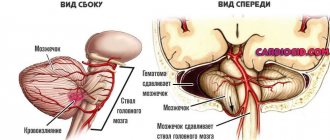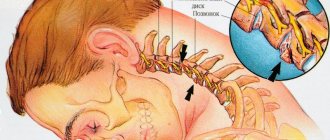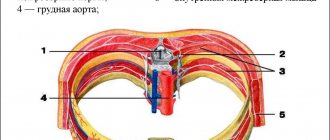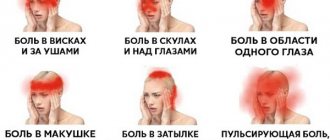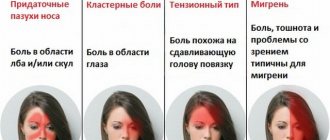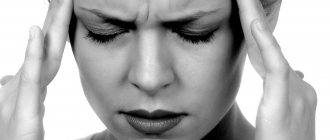Cephalgia (the scientific name for a symptom, discomfort in the cranial area) is the result of inflammatory, degenerative, tumor, vascular processes and other disorders of the body.
The sign is nonspecific; doctors struggle for months to find the cause of the deviation from the norm. With varying degrees of success.
Headache tablets are a generalized name for a wide group of medications; they are heterogeneous in nature and combat various aspects of discomfort: arterial spasm, disruption of tissue integrity, disorders of vascular function and tone.
There are a great many names, as well as categories of drugs, numbering in the hundreds.
In any case, you should not take medications without permission, even relatively well-known and seemingly safe ones. They do not pose a threat only with the proper dosage regimen or if the body is strong enough.
At one point, your luck may run out and dangerous side effects may develop. For example, with anti-inflammatory drugs, these are bleeding, disruption of the integrity of blood vessels, disorders of the liver and kidneys.
If a headache develops, it is recommended to consult a therapist or neurologist. Next, to specialized doctors who will work with the problem in a meaningful way, and not just suppress the symptoms.
What does modern medicine offer to combat discomfort?
Non-steroidal anti-inflammatory drugs
Well-known and proven medications. Used in a wide group of cases. Basically, they are aimed at relieving pain of an infectious-inflammatory, autoimmune nature, discomfort in pathologies of the musculoskeletal system. They act indirectly.
If we talk about specific indications:
- Osteochondrosis. Inflammatory process of the spine. Unbearable headaches are characteristic of lesions in the collar area.
- Migraine processes, which are also caused by dysfunction of the musculoskeletal system. There are special forms of the pathological condition. They are just corrected through NSAIDs.
- Intervertebral hernia. Complication of osteochondrosis. Destruction of the disc, loss of its shock-absorbing properties. The result is compression of nerves and blood vessels, severe local inflammation. NSAIDs do not always cope in this case.
- Infectious diseases. Some anti-inflammatory drugs, for example, their ibuprofen group, also have an antipyretic effect, which is very valuable for colds, flu and ARVI.
- Autoimmune lesions of the cervical region and spine.
The task of anti-inflammatory non-steroidal origin follows from the name of the group of drugs. At the same time, they are not able to relieve severe neurological pain or discomfort in disorders of vascular origin.
As for famous names, here are some options:
Ketoprofen
A product with the widest possible spectrum of pharmacological activity. It is prescribed both for classic diseases of the musculoskeletal system and for disorders including oncology.
Of course, as a maintenance drug, since it cannot cope with such severe pain syndromes alone.
It is used as a complex medicine for colds and acute respiratory viral infections of various origins. Ketoprofen is a fast-acting NSAID, relieves pain in a matter of minutes, has a minimum of side effects, but is very demanding on compliance with the dosage regimen.
Ketorolac
It is considered a more powerful pain reliever. Has the ability to correct severe and moderate discomfort. It is also prescribed in the postoperative period.
Ketorolac, like tablets for the head, is used for inflammatory, degenerative discomfort, vascular spasms, and is prescribed as an aid in the treatment of migraine conditions.
However, power comes at a price. The product can be taken for no more than 3-5 days, but the risk of bleeding, liver and kidney damage remains. You cannot take Ketorolac without permission.
Diclofenac
A more specific remedy. Prescribed for disorders of the musculoskeletal system. It relieves arthralgia and joint symptoms well (including at the level of the cervical spine).
There is information about the negative effect of Diclofenac on the cardiovascular system. Especially with regular use. It makes sense to limit its consumption even for direct indications.
Nimesulide
As in the case of the previous one, it is prescribed mainly for the correction of headaches due to lesions of the back, spine and related anatomical structures.
Unlike Diclofenac, it is many times safer. Suitable for relatively long-term use (up to a week or a little more).
Without medical supervision, it causes disruption of the functioning of internal organs.
Nurofen
A strong, but well tolerated drug from the ibuprofen group. Nurofen is inexpensive, effective both against headaches in its pure form and for correcting the symptoms of the underlying pathological process: be it fever or local inflammation.
Available in several forms:
- The classic one works in 15-20 minutes.
- Express is better absorbed, so you can expect results almost immediately.
- Forte offers a double dosage of the active substance per tablet.
There are a lot of variations.
NSAIDs have several important benefits:
- Low cost. The products are available at any pharmacy. The cheapest is sold at a price of 60-70 rubles per pack.
- Sale without prescription.
- High speed of action. After approximately 10-20 minutes, you can expect a beneficial effect.
At the same time, if prescribed correctly, the discomfort disappears completely or mostly.
But there are also serious disadvantages:
- Lots of contraindications.
- Short terms of possible use. Even the most gentle remedies should not be taken for more than a week.
- Lots of side effects. The vessels and mucous membrane of the stomach and digestive tract are almost always affected.
For emergency correction of headaches of unknown origin, preference should be given to Nurofen and other ibuprofen-based drugs. They are the safest and have the widest spectrum of action.
If they don't help
If you have an episodic headache, then possible reasons for the ineffectiveness of painkillers
1. Dose is too small
What to do:
select the dose according to the instructions.
2. Individual sensitivity
What to do:
try different medications; one painkiller may suit you and the other may not.
3. Simple painkillers are too weak for you
What to do:
try combined analgesics (pentalgin, solpadeine, etc.).
4. You take your pills too late
What to do:
for migraines, for example, you should take the drug as soon as possible, as soon as you feel a headache.
5. You have a migraine
For migraines, we start therapy with NSAIDs and paracetamol, but these may not be effective in severe attacks.
What to do:
visit a neurologist for an accurate diagnosis; if NSAIDs are ineffective, take triptans.
Antispasmodics
In neurological diseases and some heart disorders, headaches are caused by a sharp narrowing of the blood vessels in the brain.
The nervous tissue itself cannot experience or cause discomfort. The reason is precisely the spasm of the arteries.
The drugs are designed to normalize the tone of the blood supply structures, relax them and thereby remove sensations.
Painkillers from the antispasmodic group are prescribed for neurological disorders and diseases of incompletely understood origin (for example, migraine).
If we talk about indications:
- Hypertension. In very limited quantities.
- Hormonal disruptions that lead to disorders of cerebral vascular tone.
- Migraine. Only as auxiliary drugs.
The list of reasons for use is relatively small, but in their conditional group, antispasmodics solve the problem one hundred percent.
To increase the pharmacological activity and effectiveness of drugs, they are often combined with other drugs. For example, with NSAIDs. This is how universal medications for short, symptomatic use appear.
Let's look at some options:
Novigan
A combination of several substances. It has a wide range of indications. Novigan works well to eliminate almost any headache. At the same time, it is safe enough that it can be taken for 1-2 days without the approval of the attending physician. But not more.
It has selective properties, although it can still provoke bronchospasms and other health problems. Especially with excessive consumption.
Spazgan
An analgesic and vasodilating antispasmodic at the same time. Prescribed for severe discomfort. Including when other means failed.
Used in a short course over a couple of days or as appropriate. It begins to act after 10-20 minutes.
Spasmalgon
Painkiller based on Papaverine. This substance, although old, copes well with the task assigned to it. Relieves vascular spasm. However, the compound has very limited pharmacological activity.
To enhance the effect, Spazmalgon contains Paracetamol, caffeine and several other components. For headaches, these tablets relieve excessive vascular tone, restore local microcirculation, thereby eliminating unpleasant sensations.
Antispasmodics are not a panacea. But these medications have several positive aspects:
- Relatively low price.
- High efficiency with a rapid effect on the body. To wait for a beneficial effect, only a few tens of minutes are enough.
- Good tolerance.
Among the disadvantages:
- Relatively narrow scope of application. Antispasmodics act only on vascular pain. Combinations of drugs do not count (and they do not always give results due to the relatively small dose of auxiliary components).
- Some medications have side effects such as bronchospasm, which can be dangerous.
- Antispasmodics, like tablets that help with headaches, can be taken for no more than two days, then you need to go to the doctor. Unauthorized regular use to relieve discomfort is also not allowed, since each time the likelihood of side effects increases.
It must be borne in mind that many drugs in this group are not suitable for eliminating headaches at all. These are, for example, Buscopan, No-shpa, Drotaverine, Duspatalin and many others. They have their own specifics.
Analgesics
Wide group of medicines. These drugs act on discomfort of any nature, because they eliminate nerve conduction at the local level. The circuit opens, the unpleasant sensations go away.
True, the pathological process itself, which caused the pain, does not go away, this is a huge minus. You can blur the clinical picture and remain in blissful ignorance while the body collapses.
Drugs of this type can be divided into two broad categories:
- Narcotic analgesics.
- Products based on other components.
The first ones are very difficult to get. They are sold strictly according to a prescription and require strict accounting. Yes, and they are needed in a very limited number of cases. The second ones are much more popular. They are prescribed for pain of any nature and origin. Doesn't really matter.
Classic analgesics of this type are made on the basis of metamizole sodium. They are relatively well tolerated.
At least new generation products. Here is a list of popular names of potent analgesics:
- Analgin.
- Pentalgin.
- Baralgin.
The first two are morally outdated. This doesn't mean they don't apply. But they are much less tolerated and have more side effects. The blood vessels, liver, and kidneys are especially affected. Otherwise, these drugs are approximately the same in terms of effectiveness.
Narcotic analgesics are prescribed in cases where it is simply impossible to eliminate the discomfort in any other way. For example, after a stroke, with a severe brain tumor, especially if it causes an increase in intracranial pressure, painful neuralgia, and in other situations.
This includes the powerful painkiller Tramadol and similar opioid analgesics.
The problem is that this type of remedy deals with the effect, not the cause.
Among the advantages of analgesics:
- Wide range of indications.
- High efficiency.
- Fast action.
There are also disadvantages:
- Many side effects. Especially from the internal organs and blood.
- High allergenic potential. More than previous groups.
- Impossibility of long-term use. Maximum, a few days. And then, with an eye to your well-being.
For reference:
Analgesics are taken as an emergency measure to quickly relieve headaches. A good solution would be to use a combination drug.
Antimigraine
Antimigraine drugs are effective remedies for headaches in specific cases when spontaneous vasospasm develops.
The exact origin of this pathological process is not yet clear. Scientists and practitioners suggest that the disorder is of vascular origin, this is the prevailing theory. Interestingly, in this case the arteries do not narrow, but, on the contrary, greatly expand.
Be that as it may, migraine pain cannot be relieved by practically anything. Antispasmodics have little effect, and analgesics and NSAIDs are useless.
It is to solve the problem of discomfort that anti-migraine drugs are produced.
Here are a few names:
- Migrepam.
- Relpax.
- Ergotamine-based products.
All of them cause vasoconstriction. Simply put, the drugs narrow the lumen of large vessels, thereby eliminating discomfort.
Antimigraine medications for headaches eliminate acute attacks and can be used to prevent relapses of the pathological process. However, they cannot be taken without a doctor's approval.
Advantages of the drugs:
- Highly effective against illness.
- Good tolerability and absence of side effects with proper dosage regimen.
Minuses:
- High price.
- There is no 100% guarantee of results. There are different clinical cases. Including those when you have to look for a combination of medications.
The medications that have been described are used in a narrow format. They are not suitable for anything other than treating migraines. Moreover, they pose a health hazard to certain categories of patients due to their vasoconstrictor effect.
Migraine in children, symptoms, treatment
Causes and treatment of migraine in children
In children, the disease appears suddenly and for no apparent reason, but it can be provoked by eating certain foods and Chinese dishes.
At risk:
- sugar;
- caffeine;
- chocolate;
- cheese;
- nuts.
The symptoms in a child are the same as in adults. Before illness, a child may become whiny, irritable and withdrawn, or, conversely, agitated and talkative. These children have disturbed sleep and appetite.
A child's aura is often visual. The child is not able to tell what is bothering him, and then the doctor shows pictures or asks him to draw what he sees. Usually, various lines, dots, unclear and blurry pictures appear before his eyes.
The child often feels dizzy, speech functions are impaired, memory suffers and the face goes numb. There are problems with coordination. The attack lasts 4 hours. The child becomes lethargic, taciturn, drowsy, and afraid of light. Nausea, vomiting, chills and fatigue occur. This continues for several days after the attack.
To treat migraines in children, it is necessary to follow a daily routine, protect them from stress, follow a diet; if the child is a schoolchild, then you need to reduce the study load. The attack can be stopped at home. To do this, you need to put the child on the bed in a dark and cool room so that he can fall asleep.
Depending on the duration of the attack, you can stop it with ibuprofen or naproxen, in addition to aspirin. Medicines should be given no more than 2 times a week during exacerbations.
Medicines for hypertension
Increasing pressure with increasing load on the arteries is a very specific cause of pain. This is exactly the case when other medications will be useless. Assigned by course.
There are several categories of medications. Which ones will be used and will be effective depends on the situation.
- Beta blockers. Prevents the effect of adrenaline on special receptors. List of names: Metoprolol, Propranolol, Atenolol, Bisoprolol and others.
- Calcium antagonists. Do not allow element ions to penetrate cells. Thus, optimal vascular tone is achieved and both headaches and high blood pressure are relieved. Diltiazem, Verapamil as examples.
- Centrally acting agents. Eliminate pathological signals from the brain. Moxonidine and analogs.
- ACE inhibitors. Prevents the excessive effect of angiotensin on blood vessels. Thanks to this, spasms can be eliminated. Perindopril, Perineva, Prestarium as a list of options.
- Diuretics. Non-specific drugs, but they also work.
These drugs are used in different combinations, but only in patients with hypertension. For others they are dangerous.
Why does it start
Tension headaches, the symptoms of which can be ignored for a long time, begin with:
- Chronic fatigue.
- Muscle stress (when you have to sit a lot, the cervico-facial and eye muscles become overstrained).
- Disturbance of the balance of pain and anti-pain reactions of the body.
- Uncontrolled use of painkillers and tranquilizers.
- Incorrect posture, uneven posture.
- Sudden change of weather.
- Uncomfortable position while sleeping.
- Diseases of the cervical spine.
- Abuse of alcohol and smoking.
- Being in an unventilated area.
- Malnutrition.
- Depression.
An imbalance of pain and anti-pain reactions begins with a decrease in the production of the hormone serotonin, a natural anti-pain substance. Receptors, which have their own threshold of excitation, begin to work incorrectly and send pain impulses even with slight irritation (touching, coughing, sneezing). Tension headache is accompanied by neuroses, asthenic syndromes, hypochondria
Constant stress and overwork lead to spasms, accompanied by muscle tension. Compression of blood vessels occurs. Cell nutrition is disrupted, metabolism deteriorates and pain occurs. It is known that pain is not life-threatening. She says that the body needs help to prevent the development of a serious disorder.
A person does not always realize that he is developing a depressive state in an open or closed form. Doctors can identify it by conducting special surveys. It has been proven that women often suffer from tension pain.
Precautionary measures
There are a few things to keep in mind. They reduce risks for the patient:
- You need to clearly know what causes the symptom. For example, for migraine, an inflammatory process, headache pills are used that do not affect blood pressure, since otherwise fatal consequences are possible. The same goes for hypertension. There is no point in taking analgesics if the reason is a jump in blood pressure.
- You cannot do without consulting a doctor. You cannot take pills without permission.
- Medicines for cephalalgia often provoke side effects. As soon as something changes in your health, you need to run to the doctor.
- Many medications do not combine. Do not mix different categories of medications with each other. Is it dangerous.
If the origin of the headache is unclear, you can take Nurofen, Spazmalgon, Novigan. They are relatively safe. These are inexpensive tablets that effectively relieve cephalalgia of inflammatory, vascular, or any other origin.
You can accept such names for a maximum of 1-2 days. Then you still need to go to the doctor.
Causes of migraine with aura
- Stressful conditions;
- Lack of sleep;
- Sudden temperature changes;
- The light is too bright;
- Constant noise;
- Monitor flickering;
- Strong odors;
- Excessive sexual activity;
- Menses;
- Long-term use of contraceptives;
- Therapy with hormones.
It has been noticed that people who do not complain about life and are optimistic about it are much less likely to suffer from migraine attacks than those who experience a constant feeling of dissatisfaction and irritability. People who suffer from this type of migraine include: hypochondriacs, patients with depressive neurosis and sleep disorders, and those with chronic fatigue syndrome.
Necessary examinations for headaches
It is important to understand where the cause of the disorder is. Forecasts depend on this. You need to see a therapist, he will refer you to a specialized specialist. Among the diagnostic methods:
- Patient interview. Identification of symptoms of the pathological process.
- Anamnesis collection.
- X-ray of the skull.
- Ultrasound of cerebral vessels. In different modes. Often it is disturbances in cerebral blood flow that cause discomfort.
- Blood pressure measurement.
- Daily monitoring. About the same thing, only for 24 hours.
- ECG, ECHO. As part of assessing the condition of the heart and large local vessels.
- MRI of cerebral structures, back.
- X-ray of the spine.
- Encephalography.
- General blood test, biochemistry. Also hormone tests if there is any suspicion.
This list in different combinations is prescribed to patients with an unclear genesis of headache. Next, it’s up to the doctor on site.
Tablets for cephalalgia are not a panacea, but a temporary symptomatic measure. You need to work with the root cause (they are described here).
Migraine symptoms
This disease is different from others. It appears suddenly, does not respond to analgesics and also disappears imperceptibly. Migraine symptoms include pain on one side of the head and can last from half an hour to five days. It can be in the area of the eyes, forehead and temples.
Patients are often irritated by bright lights and loud sounds. At the same time, the pressure remains normal. A person may experience nausea, sometimes accompanied by vomiting. This occurs spontaneously, without reference to a stroke or brain tumor, and sometimes may indicate the development of such pathologies.
There are several types of migraine:
- Ocular, without aura,
- Hemiplegic,
- Cervical.
Headache rarely occurs on both sides of the head. The appearance of migraine in such cases is associated with blood vessels, but has nothing to do with an increase or decrease in blood pressure. Intracranial pressure or attacks of glaucoma also have no reason to cause migraines. This is a completely different kind of headache.
Interesting fact! Even before the birth of Christ, this disease was known, but it had no name. Later, the great Hippocrates described the symptoms of the disease (around 400 AD) and designated its name. However, the founder of its classical name was the ancient Roman physician Claudius Galen.
And he also made the discovery about the localization of pain. Many geniuses were accompanied by this disease. It is inherent in people who prefer mental work. Many brilliant personalities suffered from this illness: (Pontius Pilate, Pyotr Tchaikovsky, Edgar Allan Poe, Karl Marx, Anton Pavlovich Chekhov, Julius Caesar, Sigmund Freud, Darwin, Newton).

